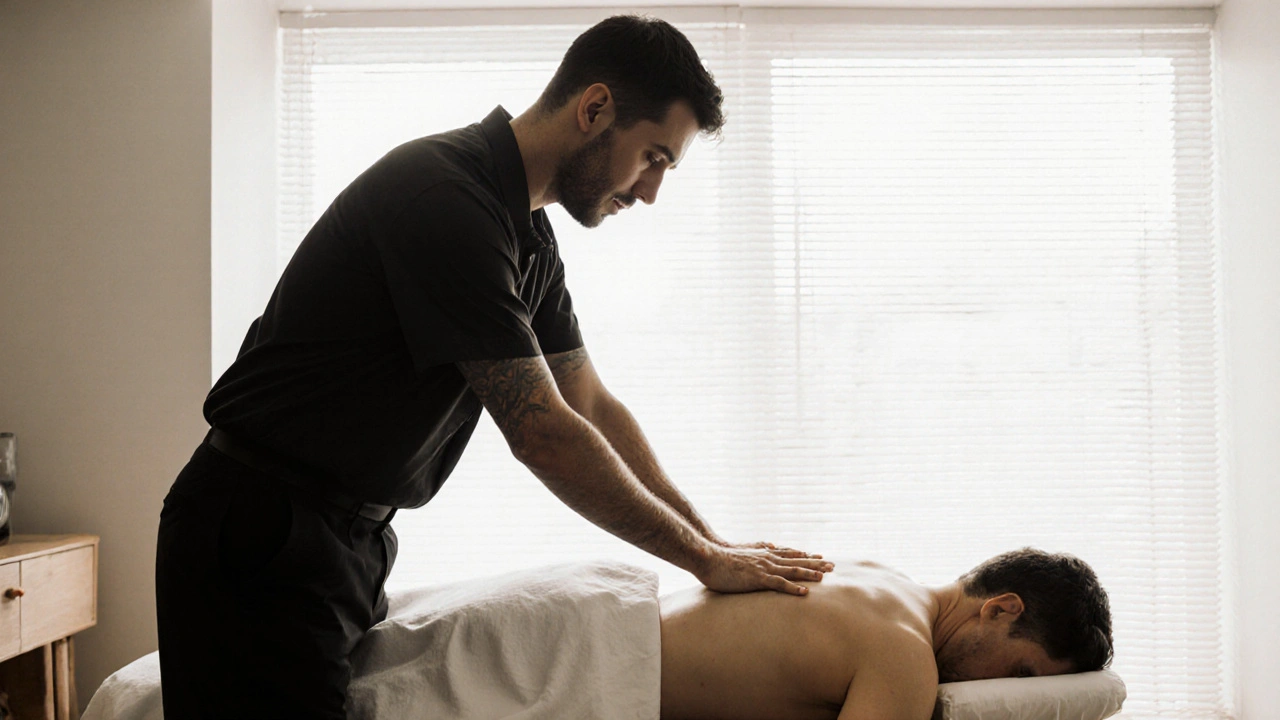Gay Massage Myth Checker
Test Your Knowledge: Gay Massage Myths vs. Facts
Answer these 5 questions to see how much you know about gay massage. Each question has one correct answer.
1. Is gay massage sexual?
2. Can straight men book a massage from a gay therapist?
3. Are gay massage therapists less qualified?
4. Is gay massage more expensive?
5. How do you know if a therapist is professional?
Your Score
Gay massage isn’t about sex. It’s about touch that heals, relaxes, and restores. Yet too many people still assume it’s something else entirely. If you’ve ever been told to avoid a gay masseuse because of what they might "do," or if you’ve hesitated to book a session because you feared being judged - you’re not alone. And you’re wrong to feel that way.
What Gay Massage Actually Is
Gay massage is simply massage performed by or for gay men. It’s not a special technique. It’s not a fetish service. It’s not a loophole for sexual activity. It’s the same Swedish, deep tissue, or sports massage you’d get from anyone else - just delivered by someone who happens to be gay.
Think of it this way: a woman doesn’t give "lesbian massage." A Black therapist doesn’t offer "Black massage." Why should a gay man’s touch be labeled differently? The answer is simple: stigma. The label "gay massage" exists because society still links male-male touch with sexuality, even when there’s zero sexual intent.
Professional gay massage therapists are trained, certified, and bound by strict ethical codes. They work in clinics, spas, and wellness centers. Many specialize in chronic pain relief, sports recovery, or stress reduction. Their clients include gay men, straight men, women, and non-binary people. The only thing that makes it "gay massage" is the identity of the provider - not the service.
Why This Matters for Mental Health
For many gay men, touch has been dangerous. Growing up, physical affection between men was often mocked or punished. Hugs were rare. Shoulder pats were awkward. Intimacy was tied to shame. As adults, some gay men avoid touch altogether - not because they don’t want it, but because they’ve been taught to fear it.
Massage changes that. A skilled therapist creates a space where touch is safe, intentional, and healing. Studies show that regular massage reduces cortisol levels by up to 31% and increases serotonin and dopamine. For gay men dealing with anxiety, depression, or trauma from coming out, that’s not a luxury - it’s medicine.
One client in Melbourne told me he hadn’t been hugged by another man since he was 16. After six weekly sessions with a gay massage therapist, he started hugging his brother again. "It wasn’t about the pressure on my back," he said. "It was about realizing my body could be held without judgment."
Breaking the Myths
Let’s clear up the biggest lies:
- Myth: Gay massage is sexual. Truth: Licensed therapists follow the same professional boundaries as any other healthcare provider. Sexual misconduct is grounds for immediate license revocation - and it’s rare.
- Myth: Only gay men get these massages. Truth: Straight men book them all the time. They’re looking for comfort, relief from tight shoulders, or just someone who doesn’t make them feel weird for wanting touch.
- Myth: It’s not "real" therapy. Truth: Many gay massage therapists have degrees in physiotherapy or sports medicine. Some work alongside doctors treating chronic pain or lymphedema.
- Myth: It’s expensive or hard to find. Truth: In cities like Perth, Sydney, and Melbourne, there are dozens of certified practitioners. Prices are the same as any other massage clinic - $70 to $120 per hour.
There’s no secret code. No hidden agenda. Just a person trained to relieve tension - and a client who deserves to feel safe doing it.

What to Expect in Your First Session
If you’ve never had a massage from a gay therapist, here’s what actually happens:
- You fill out a health intake form - same as any clinic.
- You discuss your goals: sore back? stress? tight hamstrings?
- You undress to your comfort level. Sheets cover you at all times.
- The therapist uses oil or lotion and applies pressure based on your feedback.
- You talk if you want to. You stay silent if you prefer.
- You leave feeling lighter, calmer, and more connected to your body.
There’s no flirting. No innuendo. No pressure. No "extra services." The therapist’s job is to listen - not to read your mind, but to follow your cues.
One client in Perth said he expected the therapist to make a comment about his physique. Instead, the therapist asked, "Does this pressure feel right?" That’s it. And that moment - quiet, professional, respectful - changed everything.
Why This Is a Form of LGBTQ+ Wellness
Wellness isn’t just about yoga and kale smoothies. It’s about reclaiming your body after years of being told it’s wrong. For gay men, that often means healing from the message that their touch is dirty, their affection is suspect, their presence is a threat.
Gay massage therapists are quietly doing something radical: normalizing male-male touch as a human need, not a sexual act. They’re helping clients - gay or not - unlearn fear. They’re creating spaces where a man can lie on a table, close his eyes, and breathe without wondering if he’s being watched, judged, or desired.
This isn’t niche. It’s necessary. In a world where suicide rates among gay men remain higher than average, where loneliness is epidemic, and where physical isolation is common - touch is a lifeline.

How to Find a Reputable Therapist
You don’t need to search for "gay massage" to find a good therapist. Look for:
- Registration with a national body like the Australian Association of Massage Therapists (AAMT)
- Certifications in anatomy, physiology, and therapeutic techniques
- Clear policies on consent and boundaries on their website
- Reviews from other clients (look for mentions of professionalism and safety)
Many clinics don’t advertise the therapist’s sexual orientation - and that’s fine. What matters is their skill, ethics, and ability to make you feel safe.
If you want to support LGBTQ+ wellness, consider booking with a therapist who openly identifies as gay. Their work is part of a larger movement: making healthcare inclusive, not just politically correct.
What This Means for Everyone
Gay massage isn’t just for gay men. It’s for anyone who’s ever felt uncomfortable being touched - or who’s ever assumed touch meant something it didn’t.
It’s for the straight dad who wants to relieve his back pain but doesn’t want to be stared at. It’s for the trans man who’s been turned away by clinics that "don’t know how to handle" his body. It’s for the woman who just wants a deep tissue session without being hit on.
When we stop labeling massage by the therapist’s identity, we start treating touch as what it really is: a basic human need. And when we stop fearing it, we start healing from it.
The next time you hear someone say "gay massage" like it’s odd or risky - ask them: "What’s the difference?"
There isn’t one.
Is gay massage sexual?
No. Professional massage therapists - regardless of sexual orientation - follow strict ethical codes. Sexual activity during a session is a violation of licensing rules and is extremely rare. Gay massage is therapeutic touch, not sexual service.
Can straight men book a massage from a gay therapist?
Yes, and many do. Clients choose therapists based on skill, comfort, and reputation - not sexual orientation. Straight men often report feeling more relaxed with gay therapists because they don’t feel the pressure to perform masculinity or fear unwanted advances.
Are gay massage therapists less qualified?
No. All licensed massage therapists in Australia must complete accredited training and pass national certification. Sexual orientation has no bearing on skill, knowledge, or professionalism.
Is gay massage more expensive?
No. Pricing is based on session length, location, and therapist experience - not identity. A 60-minute massage typically costs between $70 and $120, whether the therapist is gay, straight, or non-binary.
How do I know if a therapist is professional?
Look for registration with the Australian Association of Massage Therapists (AAMT) or similar bodies. Check their website for clear consent policies, hygiene standards, and client testimonials. Avoid anyone who doesn’t provide this information or makes you feel uncomfortable.


 Health and Wellness
Health and Wellness